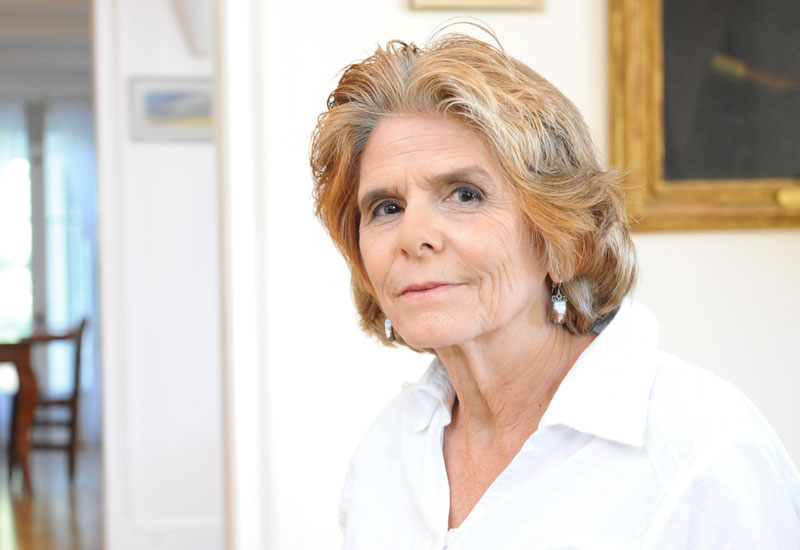Elizabeth Shafer '66: Opposing Nuclear Weapons

The Republic of the Marshall Islands—once used by the United States to conduct nulear weapons testing—is bringing a case before the International Court of Justice, but its not for the reasons one might assume.
For more than a decade following World War II, the islands were used to conduct 67 nuclear weapons tests, including Castle Bravo, the first hydrogen bomb and the largest nuclear test ever conducted by the U.S.
Elizabeth Stillman Shafer ’66, who is aiding in the islanders’ legal fight, says residents were exposed to large doses of radiation and the after-effects included cancers, reproductive problems, and birth defects.
The Republic is not seeking money damages, she says—some, though inadequate, monetary compensation has been provided since the tests were conducted. It is seeking declaratory and injunctive relief, using the Court’s power to force an answer from nuclear states about why they have not begun good-faith multilateral negotiations on eliminating nuclear weapons.
The case is supported by the Lawyers Committee on Nuclear Policy, where Shafer has served as an officer, and pits the Marshall Islands against nine nuclear powers—including the U.S. Shafer helped draft an amicus curiae brief on behalf of the Marshall Islands in a companion case in U.S. federal court. She is hoping the initiative will hasten long-awaited multilateral negotiations about banning nuclear weapons.
Prior to graduating from City University of New York Law School at Queens College in 1991, Shafer married medical doctor and public health official Stephen Quentin Shafer, and the couple had three children, one of whom also gravitated to the field of human rights. Shafer and her husband live on a sheep farm in Saugerties, New York, where she spends a good deal of her time on a life-long passion: creating art. She studied oil painting with Hughie Lee-Smith at the Art Students’ League, woodblock printing with Ansei Uchima at Columbia University in New York, and oil painting with HongNian Zhang at the Woodstock School of Art. More recently she edited a book on her great-great aunt—The Art of Clara Francis Stillman (Brilliant Graphics, 2014)—and was a contributor at the Bread Loaf Writers’ Conference in 2014 and 2015. She’s now taking workshops in encaustics and continuing with creative writing in her spare time.
While she greatly enjoys her life pursuits, Shafer’s passion to advocate for a nuclear-free world has been the driving force in her professional life.
“I was interested in environmental matters, and the only issue I really wanted to work on was abolishing nuclear weapons, so I volunteered at the Lawyers Committee on Nuclear Policy,” Shafer says.
In that role, she’s worked pro bono cases, written legal papers on nuclear-related subjects, and helped draft the 1997 Model Nuclear Weapons Convention, which is now an official U.N. document highlighted by U.N. Secretary General Ban Ki Moon.
“It seems that our work just goes on and on, and it’s a question of trying to change political will so that something will be done,” Shafer says. “After the disaster in Fukushima occurred, our mandate to advocate for phasing out nuclear power as well as nuclear weapons became even more relevant because they both entail problems concerning proliferation of nuclear weapons and long-term storage of radioactive wastes.” Radiation leaks from nuclear power plants, for example, could contribute to thyroid cancer, she notes.
One of the strongest arguments against nuclear weapons, Shafer says, is the incompatibility of these weapons with existing international humanitarian law. The use of nuclear weapons—the enormous explosive force they expel and the uncontrollable effects of radiation that result—can mean the suffering and death of untold numbers of civilians. Shafer adds that nuclear weapons are prohibited under international legal rules of discrimination (which prohibit weapons that are unable to discriminate in their effects between military and civilian targets) as well as under the rule of necessity (allowing a state only to use that degree of force as is necessary to achieve the objective of a particular military strike), and of proportionality (disallowing weapons whose potential effects on civilians or the environment would be disproportionate to the military advantage of the strike).
The nuclear proliferation issue has certainly kept Shafer busy. She authored the paper “Good Faith Negotiation, the Nuclear Disarmament Obligation of Article VI of the NPT and Return to the International Court of Justice,” which she presented at the 2006 International Association of Lawyers Against Nuclear Arms (IALANA) conference. It was subsequently published as one of four articles in the IALANA book Legal Obligation to Nuclear Disarmament.
Shafer has also been involved in other court cases, sometimes writing an amicus curiae brief, and other times offering support and legal opinions. In 2011, Sister Megan Rice, a nun, and two other protestors walked onto the Y-12 National Security Complex, a nuclear missile site in Oak Ridge, TN. They were convicted of sabotage in 2013, which led Shafer and others to write letters asking the judge for leniency in sentencing. The convictions were recently overturned by the U.S. Circuit Court of Appeals, and Rice, along with her fellow protesters, were freed.
It’s been a long and difficult battle, Shafer says, especially when you factor in world events following 9/11. Political support for nuclear disarmament waned as George W. Bush’s War on Terror escalated and wars and conflict raged on throughout the Middle East. She notes that, in this climate, defense rules the day and nuclear arsenals are being modernized, when efforts should really be redoubled to rid the world of nuclear weapons. Shafer says the recent negotiations with Iran are encouraging because they strengthen the nonproliferation regime—but they do not address the core problems of existing nuclear arsenals and the spread of nuclear power.
“I grew up in the ’50s during the Cold War when people had fallout shelters and they were very worried about Russia,” Shafer says. “There are just different kinds of risks now than there were when I was growing up, but it seems to us that it’s just as, if not more, dangerous.”
